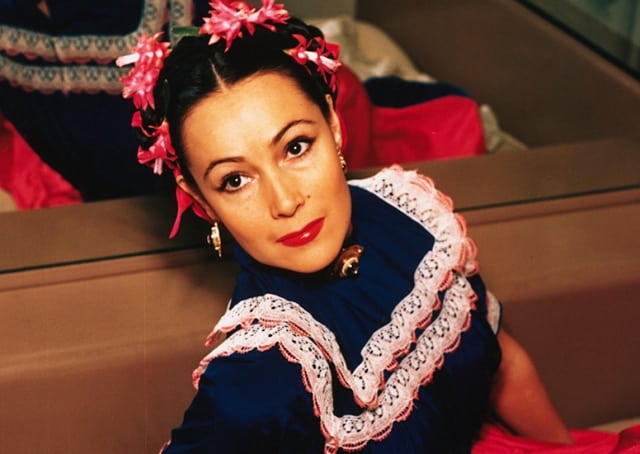Quick Facts
| Net Worth | Not Known |
| Salary | Not Known |
| Height | Not Known |
| Date of Birth | Not Known |
| Profession | Actresses |
Dolores Del Río was a Mexican star actress who is considered a pioneer and an iconic figure for bringing about the Golden Age of Mexican cinema. She is the first major Mexican actress to feature in Hollywood productions, thus, giving her that international appeal. She is one of the most famous women of the twentieth century and also one of the most beautiful faces to ever grace the silver screen. Read all you need to know about the mexican icon and her role in bringing mexican actors to the world.
Biography
The stellar actress was born on August 3, 1904, with the birth name Lolita Dolores Martínez Asunsolo López Negrette into a wealthy home in Durango City, Mexico. As was the way of life in those days, the wealthy educated their wards in Catholic schools and Dolores Del Río was no exception.
She attended the Collège Français de Saint-Joseph (St Joseph’s Covent) in Mexico City and was presented to the King and Queen of Spain in 1919. She furthered her academic pursuits studying in Madrid and in Paris. She made her movie debut in 1925 with the film titled Joanna but would knock on the door of fame with the film What Price Glory in 1926. She went ahead to be starred in many films over the years working with some of the top Hollywood actors at the time.
5 Facts You Need To Know About Dolores Del Río
Parents and Family Life
As mentioned before, Del Río came from a wealthy home. Her parents were aristocrats in Mexico before the Mexican Revolution in 1916. Her father was Jesus Leonardo Asunsolo Jacques, son of a wealthy farmer and he himself was director of the Bank of Durango. Her mother, Antonia Lopez Negrete belonged to one of the richest families in the country with her lineage traced back to Spain. Being so wealthy, they lived lavishly but had to leave the country during the Revolution, therefore, losing all their wealth.
Talent Discovery
Unlike some who go all out to discover their talents, it can be said in the case of Dolores Del Río that her talent discovered her. She was spotted by film director Edwin Carewe while performing (a dance tango) at an event her family had organized for family and friends. Her interest was initially in dancing but the director convinced her to try acting as it was fitting for her beauty. He said he saw a movie star in the making and offered her a role in his upcoming film titled Joanna (1925).
Determined to further pursue her dreams and become a movie star, she decided to move to the United States, Hollywood, to be precise alongside her husband, Jaime Martínez del Río y Viñent (otherwise called Jaime del Río, for short).
Achievements
Being credited as the first Mexican movie star to achieve international recognition and pave way for a generation of other Latino actors in Hollywood is a very notable achievement. Her association with Mexican film director, Emilio Fernandez is also said to be responsible for creating what has been known as the “Golden Era of the Mexican Cinema” with films such as Maria Candelaria (1944), The Abandoned (1945), and Bugambillia (1945).
Del Río’s acting career saw her become the first in many aspects as long as entertainment in Mexico, and by extension, the Latino world is concerned. She was a pacesetter in her career and paved the way for other Latino actresses to succeed in foreign film industries today. In fact, her work in Hollywood laid the foundation on which stars like , , , and found success.
Her recognitions and awards are numerous and include a statue built in her honor in Hollywood.
Challenges
Notwithstanding her success on the international scene, Dolores Del Río experienced some setbacks as a result of cultural discrimination. This was coupled with her Hispanic accent, which came into reckoning as the film industry slowly transitioned from the era of silent films to that of ‘speaking’ films in 1928. This changed the tide for her as roles were designed with Hollywood clichéd ideas of ethnic minorities in mind.
Del Río was aware of her unique position in American cinema and tried to balance the limited opportunity for Latino actors like herself while still not offending her Mexican audience. In fact, one of her films was banned from being played in Mexican cinemas by the Mexican government on the notion that it was antagonistic to the country’s culture.
These, among other things, informed her decision to return to Mexico in 1943 which turned out to be for a greater good in her career as that presented her with more opportunities to excel.
Personal Life
Dolores Del Río got married to her first husband Jaime del Rio, an attorney who happened to be much older than her in 1921. They got divorced after 7 years of marriage in 1928 but Del Río retained his name, long after they have separated.
She got into a relationship with Cedric Gibbons and after dating for nine months, the couple got married in August 1930. They later divorced after ten years of marriage in 1941. Del Río tried to move on with well-known filmmaker Ossen Welles that same year but the relationship did not last. She is also known to have had affairs with some top Hollywood actors.
She later had her third marriage with Lewis A. Riley in 1959 which lasted till her demise on April 11, 1983. Lewis was said to have been by her side until her last moment.
Bonus Fact – Death
In her later years, Dolores Del Río succumbed to a number of chronic ailments. She was struck by arthritis and was first diagnosed with osteomyelitis in 1978 before another diagnosis three years later revealed that the thespian had come down with Hepatitis B (which further degenerated to cirrhosis in 1982).
She died one year later at the age of 78 (April 11, 1983) and results showed it was due to a failed liver. Her body was cremated and sent back to her home country, Mexico for interment.
Top 3 Richest Actresses
>>> View Top 10 Richest Actresses In The WorldAlso Read: Top 10 Richest People in the world with full biography and details.




